Dinosaurs and other fossil remains
Following the drainage of the Fens in the 1650s the soil shrank and the land sank below the level of the rivers. Engineers shored up the riverbanks with gault clay extracted from the Roswell Pits in 19th and 20th centuries. The gaulters (as the clay diggers were known) were astonished to unearth numerous bones of giant marine reptiles. Many of these are kept in the Sedgwick Museum in Cambridge and some are photographed here. These discoveries were made at a time when the scientific world was just becoming aware of dinosaurs and the enormous expanse of geological time. It was on account of these finds that Roswell Pits were originally declared a Site of Special Scientific Interest (SSSI).
The clay dug from the pits belongs to a layer stretching from Dorset to the Humber and beyond known as the Kimmeridgian (after the Dorset village of Kimmeridge). It was laid down in a shallow sea between 157 and 152 million years ago (i.e. in the latter part of the Jurassic Period) and is famed for the number of exciting fossil finds. It also happens to be the source rock for North Sea oil.
Most of the bones found in the Roslyn Pits belonged to sea creatures, including some giant marine reptiles (strictly speaking not dinosaurs). Photo 1 shows the vertebral column ("back bone") of an enormous Plesiosaur. These fish-eating reptiles had long necks and propelled themself with four flippers. Their long, flexible necks were probably an adaptation that allowed them, despite their huge bulk, to follow and snatch rapidly darting fish.
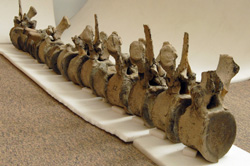 1. Plesiosaur vertebrae
1. Plesiosaur vertebrae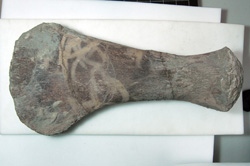 2. Pliosaur limb
2. Pliosaur limb 3. Pliosaur limb
3. Pliosaur limb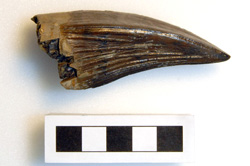 4. Pliosaur tooth
4. Pliosaur toothClosely related to the plesiosaurs were the terrifying pliosaurs whose remains were also dug from the Pit (photos 2-6). Pliosaurs were huge, powerful marine reptiles with a shorter, stout neck: they resembled crocodiles with fins in place of legs. With their elongated, powerful jaws and rows of conical teeth (photos 4-6) they were formidable predators of the Jurassic seas. The pit also yielded the remains of actual marine crocodiles (Dakosaurus) and turtles: a portion of a crocodile's jaw, a section of scute (the tough armor covering much of a croc's skin) and even a vertebra are pictured in Photos 7-9.
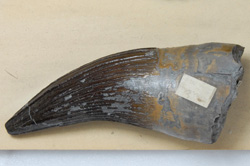 6. Pliosaur tooth
6. Pliosaur tooth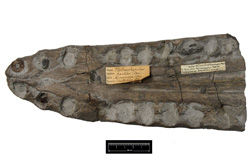 7. Crocodile Jaw
7. Crocodile Jaw 8. Crocodile Scute
8. Crocodile Scute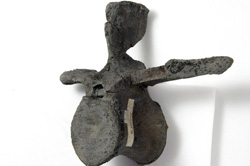 9. Crocodile Vertebra
9. Crocodile VertebraFossils of several types of extinct fish were found in the Pits. These include a shark, identified as Asteracanthus ornatissimus, whose fin spine, studded with tubercles and with a serrated edge, is shown (photo 10). Many sharks, both ancient and modern, have fin spines projecting vertically in front of the dorsal fin and are believed to perform a defensive function. A shark's skeleton is made of cartilage and doesn't preserve well, so the spines and teeth are often all that remain. The rows of rounded teeth set in the jaw pictured in Photos 11 & 12 belonged to a fish called Gyrodus and were used to crush its prey, probably shellfish (molluscs and crustaceans). The fish itself was laterally flattened and circular (i.e. disc-shaped). Caturus fish were fast-swimming predators with powerful jaws and, as can be seen in Photo 13, a fine array of needle-sharp teeth.
 5. Pliosaur tooth
5. Pliosaur tooth 10. Shark fin spine
10. Shark fin spine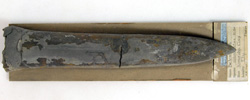 16.Belemnite
16.Belemnite 18. Dinosaur bone
18. Dinosaur boneCuriously, unlike other Kimmeridgian sites, the mollusc shells from the Hole are comparatively few and of poor quality. This is thought to be because the site is more acidic than elsewhere so the shells dissolved. Nevertheless, ammonites have been found there (Photo 14). The curious paired shells in Photo 15 look like some kind of bivalve (clams, mussels, oysters etc.), and were initially misidentified as such, but turn out to be the aptychi, the protective "doors" closing the mouth of an ammonite shell when the animal retreats within. Ammonites, while they look like giant snails, are in fact cephalopods more closely related to squid and cuttlefish. They swam freely in the open ocean buoyed by air-filled cells in their shells much as their close living relatives the nautili do today.
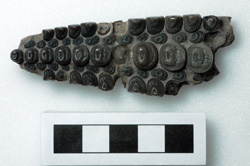 11. Gyrodus
11. Gyrodus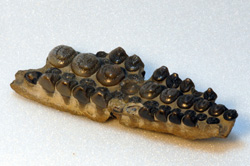 12. Gyrodus
12. Gyrodus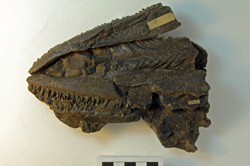 13. Caturus
13. Caturus 14. Ammonite
14. AmmoniteAnother cephalopod fossil found in the Pits is the belemnite. These creatures were similar to squid but, unlike squid, had within their body a bullet-shaped "guard" (Photo 16), which, being composed of hard calcite, is usually the only part preserved. They also had hard, air-filled cells for buoyancy, although these were more delicate and less likely to be fossilised. A number of bivalve fossils, such as the cockle-like shells in Photo 17, were also found in the Pits.
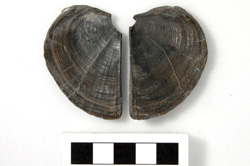 15. Aptychi
15. Aptychi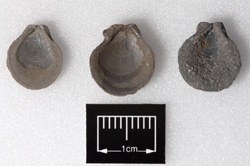 17. Bivalves
17. Bivalves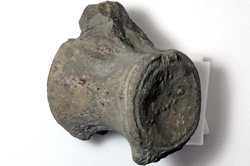 19. Dinosaur vertebra
19. Dinosaur vertebra 20 Dinosaur
20 Dinosaur
 The burning question that all children (young and old) will want to ask is, "Were dinosaurs found here?" And the answer is "yes"! Photos 18-20 show fossils remains of sauropods, familiar giant dinosaurs with long necks
and tails. They were derived from at least two different species, possibly Duriatitan humerocristatus (= "titan lizard with a crest on its humerus") and Gigantosaurus megalonyx (= "giant lizard with large claws") although
their precise identification is problematic since only a few bones were found. Why, you may ask, would bones of land dinosaurs be found in deposits laid down in the sea? Probably their corpses were washed out to sea,
perhaps during a flood.
The burning question that all children (young and old) will want to ask is, "Were dinosaurs found here?" And the answer is "yes"! Photos 18-20 show fossils remains of sauropods, familiar giant dinosaurs with long necks
and tails. They were derived from at least two different species, possibly Duriatitan humerocristatus (= "titan lizard with a crest on its humerus") and Gigantosaurus megalonyx (= "giant lizard with large claws") although
their precise identification is problematic since only a few bones were found. Why, you may ask, would bones of land dinosaurs be found in deposits laid down in the sea? Probably their corpses were washed out to sea,
perhaps during a flood.
The photographs of these Ely fossils were taken by Matt Riley of the Sedgwick Museum in Cambridge. The actual specimens and many other fossils from Ely can be seen at the Sedgwick Museum on the Downing Site, Cambridge, UK. More fossils can be seen and handled at the Old Gaol Museum in Ely.




